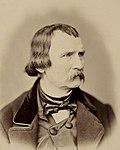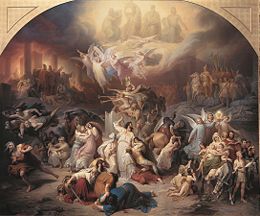The Battle of the Huns: Die Hunnenschlacht (1834–1837) :カウルバッハ 『 フン族の戦い』
http://nam-students.blogspot.jp/2010/07/battle-of-huns.html
http://nam-students.blogspot.jp/2010/07/battle-of-huns.html
Kaulbach The Tower of Babel, The Rise of Greece,The DestructionofJerusalem, The Battle of the Huns, The Crusades, and The Reformation.
http://nam-students.blogspot.jp/2016/07/kaulbach-tower-of-babel-rise-of.html
http://nam-students.blogspot.jp/2016/07/kaulbach-tower-of-babel-rise-of.html
ヘーゲル歴史哲学
 The Battle of the Huns Wilhelm von Kaulbach
The Battle of the Huns Wilhelm von Kaulbachフロイトの超自我の概念が示すのは、自己批判や良心といった社会的に高く評価されるような心の働きが実は無意識的なものであるとうことなのである。基本的には超自我と自我との葛藤は外界と内界の対立であるのだが、超自我の出現により外界と内界の戦いは戦場を変えて道徳性をめぐる戦いとして形を変えていく。このような舞台の転換をフロイトは、絵のたとえを用いて説明している。すなわち、「フン族の戦を描いたカウエルバッハの絵のように、高い場所で続けられているのである。」高邁な道徳性(いと高きもの)をめぐる戦いが、実は「いと深きものも」の代理戦争であると捉えるところに、内面化された社会規範というだけでは収まりきらない超自我の一端が現れているといえるだろう。
http://currypanman.blog5.fc2.com/?mode=m&no=16
http://en.wikipedia.org/wiki/Hunnenschlacht_(Liszt)
《超自我の発生史の教えるところでは、自我とエスの対象備給との早期の葛藤が、その対象備給の遺産である超自我との葛藤として受け継がれることがありうる。もし自我がエディプス・コンプレクスを支配するのに成功しなかったならば、エスに由来するコンプレクスのエネルギー備給は、ふたたび自我理想の反動形成となって作用するだろう。この理想とこの無意識的な衝動興奮とのおびただしい交通は、理想自身が大部分は無意識であり、自我に通じることができないままでいるという謎を解くであろう。深層で荒れ狂い、すみやかな昇華作用と同一視によって終りにならなかった戦いは、フン族の戦闘を描いたカウルバハの絵のように、より高い領域でつづいている。》
(「自我とエス」フロイト著作集6,284頁)
1834~7カウルバッハ、フン族
1846ドイツイデオロギー
1923フロイト自我とエス
参照:フロイト「自我とエス」1923『自我論集』p244,#3(/5)ラスト
付録:
以下は銅版画版。

「…カウルバッハによって予言的に描かれた匈奴の戦いが現実におこっている。」大月全集3,74頁
「 一八四五年度の『ヴィーガント季刊誌』第三巻のなかで、カウルバッハによって予言的に描かれた匈奴の戦いが現実におこっている。死んでもなお怨み消えやらぬ斃(たお)された者、たちの霊どもが空中でどよめかす叫喚と号哭に戦いの音、鬨(かちどき)の声、剣、楯、鉄車の響きがまざる。しか問題は地上の事どもにあるのではない。聖なる戦いは保護関税、憲法、馬鈴薯病、銀行制度、鉄道のためにおこなわれるのではなくて、霊のいとも神聖なる関心事、つまり「実体」、「自己意識」、「批判」、「唯一者」、「真の人間」のためなのでる、われわれは教父たちの宗教会議の座にいるのである。彼らはこの種の人たちの最後の標本であり、それにおらくはこれが至高のもの、つまり絶対的なものの事柄で弁護がおこなわれる最後の機会であろうから、審理の模様について記録をとるだけの値うちはある。
まずはじめに聖ブルーノがいる。….」(大月全集3,74頁)
Datei:Wilhelm von Kaulbach 001.jpg – Wikipedia
https://de.m.wikipedia.org/wiki/Datei:Wilhelm_von_Kaulbach_001.jpg
Die deutsche Ideologie – Wikipedia
https://de.wikipedia.org/wiki/Die_deutsche_Ideologie
https://de.wikipedia.org/wiki/Die_deutsche_Ideologie
Bruno Bauer und Max Stirner wurden auf Wilhelm Kaulbachs Gemälde Die Hunnenschlacht (1834–1837) von Marx und Engels wiedererkannt.[8]
1856年、リストはこの絵に触発されて交響詩をつくっている。
F. Liszt (1811-1886): Hunnenschlacht, Symphonic Poem N. 11
https://youtu.be/VwRfwrDY4uI
https://youtu.be/VwRfwrDY4uI
交響詩第11番 「フン族の戦い」 Hunnenschalacht (Battle of the Huns)
| |
解説
「前奏曲」と並んで最も親しみやすい作品である。1856年、チューリッヒにワーグナーを訪ねた帰途、ヴィットゲンシュタイン伯爵夫人から贈られたカウルバッハの壁画から楽想を得て、その1ヵ月後に曲を書き上げた。 前半は荒々しい戦いの描写で異教徒が猛威をふるうが、次第にコラールの旋律が精力を強めてくる。ラストはコラールの旋律が高らかに勝利を謳歌する。 | |
| 曲のテーマ 画家カウルバッハの描いた壁画「フン族の戦い」による。この壁画は紀元5世紀頃、ローマの城門で異教徒の集団であるフン族と、キリスト教徒の間で行われた戦いが描かれている。フン族の大群が攻め込むのに対して、キリスト教徒たちは十字架を掲げてこれを打ち破り、最後に光明の世界が訪れる。 |
http://classic007.web.fc2.com/list/works_sym/sy_11.html
Die Hunnenschlacht von Wilhelm von Kaulbach
http://www.bilder-geschichte.de/bilder/kaulbach-hunnenschlacht.htm
http://www.bilder-geschichte.de/bilder/kaulbach-hunnenschlacht.htm
http://catedraldeguaxupe.com.br/palavra-do-padre/20160309-2/
http://catedraldeguaxupe.com.br/wp-content/uploads/sites/31/2016/03/Jo-517-30.jpg
Art in an Age of Civil Struggle, 1848-1871, Albert Boime - 2008年9月15日, University of Chicago Press - 出版社, https://play.google.com/store/books/details/Albert_Boime_Art_in_an_Age_of_Civil_Struggle_1848?id=sEb4RL2Ru1kC
カウルバッハはヘーゲル歴史哲学を絵画で表現しようとしていたらしい。
core, and perhaps appropriately so, since Hegel was the dominant philoso-
phcr of the Vormärz epoch (1815-1848). 1
The Munich master Wilhelm von Kaulbach made an ambitious attempt
to represent the whole of Hegel's philosophy of history on the walls of the
New Museum in Berlin in six complex, encyclopedie images : The Tower or
Babel, The Rise of Greece,The Destruction of Jerusalem, The Battle of the Huns,
The Crusades, and The Reformation. By the time Kaulbach completed the
twenty-year project in 1865, however, its declamatory character was so out
of touch with the times that he wound up ridiculing it himself (fig · 7. I).
An ebullient personality like Vernet in France, Kaulbach's taste for large-
scale visual spectacles appealed to kings Ludwig I of Bavaria and Friedrich
Wilhelm IV and their tunnel vision of civic improvements. Rather than
p°sit Hegel's direct inßuence on his contemp°raries, I believe we should
examine what his ideas had in common with the work of other represen-
tatives of culture in the pre-March period-in a less grandiose format than
that projected by Kaulbach.
Kaulbach had studied monumental painting under Peter von Corne-
lius, first at Düsseldorf and than at Munich, reminding us of the central
role of the Nazarenes in the development of nineteenth-century German
art. Two diver8ing strains in paintin8 develop during the Restoration, both
receiving impulses from the Nazarenes, who now dominate the teaching
and dissemination of the fine arts : the snug, domestic style of Biedermeier,
7 · I Wilhelm von Kaulbach, 7%t
D ◆ truction ojjerusalem, 1836-1846.
Neue Pinakothek, Munich.
Art in an Age of Civil Struggle, 1848-1871
______
http://www.goethezeitportal.de/index.php?id=4185
カウエルバッハ(カウルバッハ)はゲーテの挿絵でも知られる。
ライネケきつね

http://books.google.co.jp/books?id=G574p4eKB6oC&pg=PA186
ユングがフロイトへの手紙で引用した絵(シュピールラインの伝記でも紹介されていた)。
________
http://www.goethezeitportal.de/index.php?id=4185
カウエルバッハ(カウルバッハ)はゲーテの挿絵でも知られる。
ライネケきつね

http://books.google.co.jp/books?id=G574p4eKB6oC&pg=PA186
ユングがフロイトへの手紙で引用した絵(シュピールラインの伝記でも紹介されていた)。
カウルバッハ
Kaulbach
The Tower of Babel, The Rise of Greece,The Destruction of Jerusalem, The Battle of the Huns,
The Crusades, and The Reformation.
Art in an Age of Civil Struggle, 1848-1871, Albert Boime - 2008年9月15日, University of Chicago Press - 出版社, https://play.google.com/store/books/details/Albert_Boime_Art_in_an_Age_of_Civil_Struggle_1848?id=sEb4RL2Ru1kC
上記によると、カウルバッハはヘーゲル歴史哲学を絵画で表現しようとしていたらしい。
The Tower of Babel
Battle of Salamis( The Rise of Greece)
サラミスの海戦 - Wikipedia
https://ja.wikipedia.org/wiki/%E3%82%B5%E3%83%A9%E3%83%9F%E3%82%B9%E3%81%AE%E6%B5%B7%E6%88%A6
https://ja.wikipedia.org/wiki/%E3%82%B5%E3%83%A9%E3%83%9F%E3%82%B9%E3%81%AE%E6%B5%B7%E6%88%A6
サラミスの海戦(サラミスのかいせん、ギリシア語: Ναυμαχία της Σαλαμίνας、英語: Battle of Salamis)は、ペルシア戦争最中の紀元前480年9月、ギリシアのサラミス島近海で、ギリシア艦隊とペルシア艦隊の間で行われた海戦。ヘロドトスの『歴史』(第8巻)に詳しい。
この海戦でギリシア艦隊が勝利をおさめ、ペルシア戦争は新たな局面を迎えることになる。
The Destruction of Jerusalem
エルサレム攻囲戦 (70年) - Wikipedia
エルサレム攻囲戦(エルサレムこういせん、英語: Siege of Jerusalem)は、西暦70年にエルサレムを巡って起こった攻城戦で、ユダヤ属州のユダヤ人とローマ帝国の間に起こったユダヤ戦争(第一次ユダヤ戦争)の決戦でもある。この戦いでティトゥス率いるローマ軍は、ユダヤ人の叛乱軍が66年以来立て篭もっていたエルサレムを陥落させた。エルサレム市街のみならず、有名なエルサレム神殿(ヘロデ大王が築いた第二神殿)もこのときに破壊された。なおも抵抗するユダヤ人はマサダの要塞に立て篭もり、73年まで戦い続けた。
神殿の破壊はユダヤ人の悲劇の日として語り継がれ、毎年ティシュアー・ベ=アーブの祭が行われている。この破壊を描いた絵画や文学も多い。一方、ローマはこの陥落を記念するティトゥスの凱旋門を建設し、これは今もローマ市内に残っている。
1846 Kaulbach The Destruction of Jerusalem by Titus ARTchive @ PreteristArchive.com, The Internet's Only Balanced Look at Preterist Eschatology and Preterism
http://www.preteristarchive.com/ARTchive/Exhibits/1846_kaulbach_destruction.htm
http://www.preteristarchive.com/ARTchive/Exhibits/1846_kaulbach_destruction.htm
The Battle of the Huns
The Crusades(十字軍)
The Reformation (宗教改革)
Wilhelm von Kaulbach - Wikimedia Commons
NAMs出版プロジェクト: ヘーゲル体系
http://nam-students.blogspot.jp/2010/09/blog-post_5795.html?m=0#noteh1
http://nam-students.blogspot.jp/2010/09/blog-post_5795.html?m=0#noteh1
/法=自由の概念
/__\
啓蒙とフランス革命(法、政府、愛国心)
フリードリッヒ大王、カント、1791人権宣言\/__ナポレオン
/\ /\
/__\ 近世 /_フリードリヒ大王
/宗教改革\ /\国家形成
ルター、魔女裁判_\/異端審問、1648ウェストファリア条約
王国裁判所\ /\
/__\ /君主制、ルネッサンス、学問と芸術
カール大帝のフランク王国/\ <ゲルマン世界> /\ /\
帝国分裂、協会分裂\/__\ 1215マグナ=カルタ /_1338レンゼの会議
/\ カリフ 1122ヴォルムス協約 /\
メロヴィング王家__\ 古代 /大帝国 封建制と_\ 中世 /__騎士団
民族大移動/\ /\回教/\ 位階組織/\ /十字軍/\
クロヴィウス、フランク王国、東ゴート王国_\/マホ\/トゥー/コンスタンツ\/__\/フランシスコ修道会
/\ メット ル の和議 /\
ユダヤ、エジプト\ ポワティエの /__\
/\ /\ 戦い /\ /\
ペルシャ/小アジア /__\/__\
/\ /メディア、ペルシャ /\ /\
/ \ペルシア/ \ <ヘーゲル世界史> /__\ /__\
ゼンド民族\ /キュロス王の死 /\ /\ /\ /\
/__\/__\/アッシリア、バビロニア、 /__\/__\/__\/__\
/\ /\ /没落 /\
/易経\ /ラマ教 マケドニア王国\ /東ローマ帝国
/四庫全書\ <東洋世界> / 仏教 \ /\外交/\ <古典的世界> /帝政時代\
/______\ /仏陀__シャーマニズム ペルシア戦争\/ペロポネソス戦争 /帝政\/キリスト教
/\ /\ /\ /\ /\ /七賢人 /\ /\
/国家\ 中国 /懲罰法 ヴェーダ\インド / \ /__\ギリシア/政治的、 /__\ローマ /__\
/ 書経 \ /皇帝 /\ / \ /マヌ法典\ /\精神/\ /\個人/\第2回ポエニ戦争以前 /第2回ポエニ戦争
/__家族__\/始皇帝/官僚\カースト、バラモン______\/トロヤ戦争_\/主観\/客観\/リキニウス法\/グラックス兄弟
ホメロス ギリシア神話
序論
/法=自由の概念
/__\
啓蒙とフランス革命(法、政府、愛国心)
フリードリッヒ大王、カント、1791人権宣言\/__ナポレオン
/\ /\
/__\ 近世 /_フリードリヒ大王
/宗教改革\ /\国家形成
ルター、魔女裁判_\/異端審問、ウェストファリア条約
王国裁判所\ /\
/__\ /君主制、ルネッサンス、学問と芸術
カール大帝のフランク王国/\ <ゲルマン世界> /\ /\
帝国分裂、協会分裂\/__\ 1215マグナ=カルタ /_1338レンゼの会議
/\ カリフ 1122ヴォルムス協約 /\
メロヴィング王家__\ 古代 /大帝国 封建制と_\ 中世 /__騎士団
民族大移動/\ /\回教/\ 位階組織/\ /十字軍/\
クロヴィウス、フランク王国、東ゴート王国_\/マホ\/トゥー/コンスタンツ\/__\/フランシスコ修道会
/\ メット ル の和議 /\
/ユダヤ、エジプト ポワティエの /__\
/\ /\ 戦い /\ /\
ペルシャ/小アジア /__\/__\
/\ /メディア、ペルシャ /\ /\
/ \ペルシア/ \ <ヘーゲル世界史> /__\ /__\
ゼンド民族\ /キュロス王の死 /\ /\ /\ /\
/__\/__\/アッシリア、バビロニア、 /__\/__\/__\/__\
/\ /\ /没落 /\
/易経\ /ラマ教 マケドニア王国\ /東ローマ帝国
/四庫大全\ <東洋世界> / 仏教 \ /\外交/\ <古典的世界> /帝政時代\
/______\ /仏陀__シャーマニズム ペルシア戦争\/ペロポネソス戦争 /帝政\/キリスト教
/\ /\ /\ /\ /\ /七賢人 /\ /\
/国家\ 中国 /懲罰法 ヴェーダ\インド / \ /__\ギリシア/政治的、 /__\ローマ /__\
/ 書経 \ /皇帝 /\ / \ /マヌ法典\ /\精神/\ /\個人/\第2回ポエニ戦争以前 /第2回ポエニ戦争
/__家族__\/始皇帝/官僚\カースト、バラモン______\/トロヤ戦争_\/主観\/客観\/リキニウス法\/グラックス兄弟
ホメロス ギリシア神話
/__\
啓蒙とフランス革命(法、政府、愛国心)
フリードリッヒ大王、カント、1791人権宣言\/__ナポレオン
/\ /\
/__\ 近世 /_フリードリヒ大王
/宗教改革\ /\国家形成
ルター、魔女裁判_\/異端審問、ウェストファリア条約
王国裁判所\ /\
/__\ /君主制、ルネッサンス、学問と芸術
カール大帝のフランク王国/\ <ゲルマン世界> /\ /\
帝国分裂、協会分裂\/__\ 1215マグナ=カルタ /_1338レンゼの会議
/\ カリフ 1122ヴォルムス協約 /\
メロヴィング王家__\ 古代 /大帝国 封建制と_\ 中世 /__騎士団
民族大移動/\ /\回教/\ 位階組織/\ /十字軍/\
クロヴィウス、フランク王国、東ゴート王国_\/マホ\/トゥー/コンスタンツ\/__\/フランシスコ修道会
/\ メット ル の和議 /\
/ユダヤ、エジプト ポワティエの /__\
/\ /\ 戦い /\ /\
ペルシャ/小アジア /__\/__\
/\ /メディア、ペルシャ /\ /\
/ \ペルシア/ \ <ヘーゲル世界史> /__\ /__\
ゼンド民族\ /キュロス王の死 /\ /\ /\ /\
/__\/__\/アッシリア、バビロニア、 /__\/__\/__\/__\
/\ /\ /没落 /\
/易経\ /ラマ教 マケドニア王国\ /東ローマ帝国
/四庫大全\ <東洋世界> / 仏教 \ /\外交/\ <古典的世界> /帝政時代\
/______\ /仏陀__シャーマニズム ペルシア戦争\/ペロポネソス戦争 /帝政\/キリスト教
/\ /\ /\ /\ /\ /七賢人 /\ /\
/国家\ 中国 /懲罰法 ヴェーダ\インド / \ /__\ギリシア/政治的、 /__\ローマ /__\
/ 書経 \ /皇帝 /\ / \ /マヌ法典\ /\精神/\ /\個人/\第2回ポエニ戦争以前 /第2回ポエニ戦争
/__家族__\/始皇帝/官僚\カースト、バラモン______\/トロヤ戦争_\/主観\/客観\/リキニウス法\/グラックス兄弟
ホメロス ギリシア神話
The Tower of Babel,
The Rise of Greece,
The Destruction of Jerusalem,
The Battle of the Huns,
The Crusades,
The Reformation.
ヘーゲル歴史哲学の全8個あるセクションの(中国とインドを除く)後半6個からそれぞれトピックを選んで題材にしている。
ヘーゲル『歴史哲学講義』↓
/啓蒙とフランス革命
フリードリッヒ大王,カント,1791人権宣言
/\近世/国家形成
ルター,宗教改革,魔女裁判\/異端審問,ウェストファリア条約,フリードリヒ大王
/\ <キリスト教/\
カール大帝のフランク王国\ 世界>/1215マグナ=カルタ,1338レンゼの会議,ルネッサンス
/\古代/\ /\中世/\
民族大移動\/回教\ /コンスタ,十字軍
/\ ンツの和議 /\
ユダヤ,エジプト /__\
/ペルシア\ <世界史> /\ /\
ゼンド民族\/キュロス王の死 /__\/__\
/\<東洋世界>/\マケドニア敗北\<古典的世界>\
四庫大全\ /仏教\ ペルシア、ペロポネソス/帝政,キリスト教,東ローマ帝国
/\中国/\ /\インド\戦争/ギリシア\戦争/ローマ \
/書経\皇帝_ヴェーダ\/マヌ\/トロヤ戦争 \/リキ\/第2回ポエニ戦争
法典 ニウス法
http://yojiseki.exblog.jp/8219229
Wilhelm von Kaulbach - Wikipedia, the free encyclopedia
https://en.wikipedia.org/wiki/Wilhelm_von_Kaulbach#History_of_Mankind
https://en.wikipedia.org/wiki/Wilhelm_von_Kaulbach#History_of_Mankind
Having hitherto worked almost exclusively in fresco, he spent some time in Venice and a year in Rome to prepare himself for painting the cartoon in oil for the new Pinakothek, completing it in 1846. About the same time he commenced his famous designs illustrative of the history of mankind for the Neues Museum at Berlin, which were executed by his pupils and completed in 1860. They consist of six frescoes, representing The Tower of Babel, Homer and the Greeks, The Destruction of Jerusalem, The Battle of the Huns (German: Hunnenschlacht – a painting that inspired the 1857 symphonic poem Hunnenschlacht by Liszt), The Crusaders at the gates of Jerusalem, and The Age of the Reformation.[1] The Destruction of Jerusalem was a copy of an earlier oil painting, much admired by Friedrich Wilhelm I of Prussia, which was by then already in the collection of Ludwig I of Bavaria.[2]
These major tableaux, severally 30 feet long, and each comprising over one hundred figures above life-size, were surrounded by minor compositions making more than twenty in all. The idea was to congregate around the world's historic dramas the prime agents of civilization; thus here were assembled allegoric figures of Architecture and other arts, of Science and other kingdoms of knowledge, together with lawgivers from the time of Moses, not forgetting Frederick the Great. The chosen situation for this imposing didactic and theatric display was the Treppenhaus or grand staircase in the Neues Museum, Berlin; the surface was a granulated, absorbent wall, specially prepared; the technical method was that known as "water-glass," or "liquid flint," the infusion of silica securing permanence. The same medium was adopted in the later murals in the Palace of Westminster.[1] The staircase was severely damaged during the Second World War, and only traces of Kaulbach's work remain.[3]
His perspicuous and showy manner also gained him abundant occupation as a book illustrator. Among his engraved designs are the Shakespeare gallery, the Goethe gallery and a folio edition of the Gospels. With regard to these examples of the Munich school, it was asserted that Kaulbach had been unfortunate alike in having found Cornelius for a master and King Ludwig for a patron, that he attempted subjects far beyond him, believing that his admiration for them was the same as inspiration; and supplied the lack of real imagination by a compound of intellect and fancy. Nevertheless, in such compositions as the Destruction of Jerusalem and the Battle of the Huns, Kaulbach shows creative imagination. As a dramatic poet he tells the story, depicts character, seizes on action and situation, and thus as it were takes the spectator by storm. The manner may be occasionally noisy and ranting, but the effect after its kind is tremendous. The cartoon, which, as usual in German art of the time, is superior to the ultimate picture, was executed in the artist's prime at the age of thirty. At this period, as here seen, the knowledge was little short of absolute; subtle is the sense of beauty; playful, delicate, firm the touch; the whole treatment artistic.[1]
Von Kaulbach . Expert art authentication, certificates of authenticity and expert art appraisals - Art Experts
http://www.artexpertswebsite.com/pages/artists/von_kaulbach.php
http://www.artexpertswebsite.com/pages/artists/von_kaulbach.php
Battle of Salamis - Wikipedia, the free encyclopedia
https://en.m.wikipedia.org/wiki/Battle_of_Salamis
https://en.m.wikipedia.org/wiki/Battle_of_Salamis
Salon of 1855. Prussian School. the Tower of Babel, ジクレープリント by ウィルヘルム・フォン・カウルバッハ at Art.com
http://www.art.com/products/p36990155528-sa-i9622462/wilhelm-von-kaulbach-salon-of-1855-prussian-school-the-tower-of-babel.htm?sOrig=CAT&sOrigID=150932&dimVals=150932&ui=FC32853C36C44F0CB8824F0CC15EB149&pe=true
http://www.art.com/products/p36990155528-sa-i9622462/wilhelm-von-kaulbach-salon-of-1855-prussian-school-the-tower-of-babel.htm?sOrig=CAT&sOrigID=150932&dimVals=150932&ui=FC32853C36C44F0CB8824F0CC15EB149&pe=true
Art in an Age of Civil Struggle, 1848-1871, Albert Boime - 2008年9月15日, University of Chicago Press - 出版社, https://play.google.com/store/books/details/Albert_Boime_Art_in_an_Age_of_Civil_Struggle_1848?id=sEb4RL2Ru1kC

















